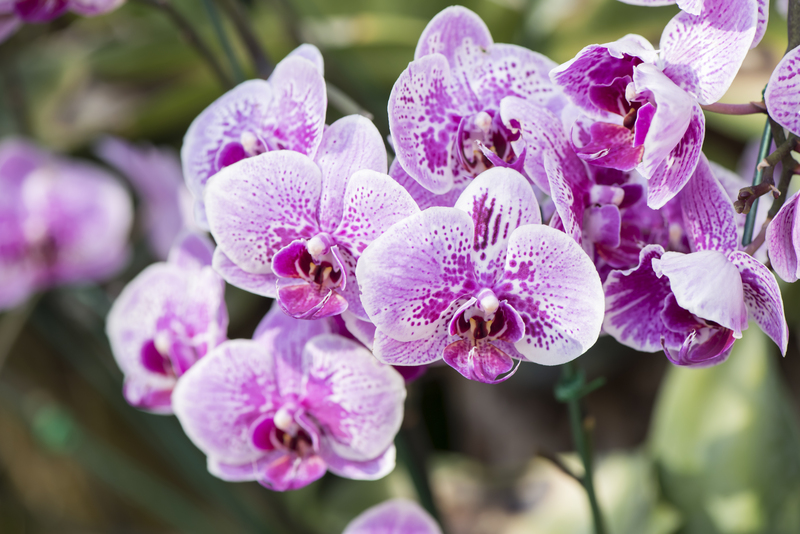Unlocking the Potential of Vertical Gardening
Posted on 04/09/2025
Unlocking the Potential of Vertical Gardening: An In-Depth Guide
Are you looking to maximize your green space or breathe new life into a concrete jungle? Vertical gardening offers an innovative solution to cultivating plants in limited spaces, transforming walls, balconies, fences, and even indoor areas into vibrant, lush ecosystems. Whether you are an urban dweller, a gardening enthusiast, or simply curious about new forms of horticulture, this comprehensive guide will help you unlock the potential of vertical gardens and elevate your greenery game.
What is Vertical Gardening?
Vertical gardening--also known as vertical planting, living walls, or green walls--is the practice of growing plants upward rather than outward, using supports such as trellises, wall-mounted planters, shelving, or hydroponic structures. This method originated centuries ago but has experienced a dramatic resurgence as modern cities face limited land and a rising demand for sustainable lifestyle solutions.
Variations of Vertical Gardening Techniques
- Living Walls: Large installations where specialist systems anchor plants to walls, often indoors for air purification and aesthetic value.
- Green Facades: Climbing plants (like ivy or jasmine) grow directly on a building's exterior using simple trellises or cables.
- Container-Based Vertical Gardens: Easily built from pots, pockets, or recycled containers mounted on fences or walls.
- Hydroponic Vertical Systems: Soilless gardens using nutrient-enriched water to grow plants, popular for urban farms and kitchen gardens.
- Pallet Gardens: Repurposed wooden pallets form a framework for plant pockets, ideal for small balconies.

Why Vertical Gardening is Booming
The rise in popularity of vertical gardening is undeniable, and for good reason. As urban spaces shrink, people are seeking creative ways to bring nature back into their lives. Unlocking the potential of a vertical garden allows individuals to enjoy the beauty and benefits of plants, even when ground space is at a premium.
Key Advantages of Vertical Gardens
- Space Utilization: Make the most of tight spaces like apartments, balconies, courtyards, and small yards. Even a narrow wall can become a lush mini-ecosystem!
- Air Purification: Living walls filter pollutants, trap dust, and lower temperatures, creating a healthier living environment indoors and outdoors.
- Insulation: Vertical gardens can act as extra insulation, protecting your building from extreme temperature shifts and reducing energy bills.
- Biodiversity: Attract pollinators, birds, and beneficial insects, enriching local urban wildlife and promoting ecological balance.
- Enhanced Aesthetics: Turn dull or unsightly walls into captivating green features that improve mental well-being and property value.
- Food Production: Grow herbs, vegetables, and fruits in areas previously deemed non-arable, supporting local food resilience.
- Noise Reduction: Dense foliage absorbs and blocks noise, creating a quieter, calming atmosphere in busy neighborhoods.
Unlocking the potential of vertical gardening is more than a trend--it's a smart response to global urbanization and environmental challenges. Let's explore how you can get started with your own vertical oasis.
Planning Your Vertical Garden
Before installing your own vertical garden system, thoughtful planning ensures long-term success. Consider the following key steps as you embark on your journey to unlock the benefits of vertical gardening:
Site Selection and Assessment
- Sunlight and Shade: Observe the amount of daily sunlight your chosen area receives. South-facing walls capture the most light, suitable for sun-loving plants, while east or north-facing areas work better for shade-tolerant species.
- Water Access: Convenient watering solutions--such as irrigation systems or easily accessible hoses--are critical, especially for densely planted vertical walls that may dry out quickly.
- Wall Strength: Assess the structural stability of your chosen surface. Living walls, especially with soil or water systems, can be heavy and may require reinforcement.
- Climate Considerations: Consider local weather patterns, temperature fluctuations, and potential wind exposure which can impact plant selection.
Choosing the Right Vertical Gardening System
With several design options available, pick a system that fits your space, skill level, and desired look. Here are a few popular vertical garden structures:
- Pocket Planters: Fabric panels or pockets mounted to walls, ideal for herbs and small ornamentals.
- Stacked Planter Boxes: Shelves or modular cubes that stack vertically, easy to maintain and rearrange.
- Trellises & Green Screens: Classic climbing frames for vegetables, flowers, or vines.
- Living Picture Frames: Succulents and air plants arranged in shallow framed planters for stunning wall art.
- DIY Pallet Gardens: Economical and customizable, perfect for renters or beginners.
- Hydroponic Towers: Advanced solutions for soilless, high-density planting.
Selecting the Best Plants for Vertical Gardens
Not all plants are created equal when it comes to thriving in vertical environments. Successful vertical garden plant selection hinges on matching species to light, moisture, and microclimate conditions.
Best Edible Plants for Vertical Gardens
- Herbs: Basil, mint, oregano, thyme, parsley, cilantro, and chives flourish in pocket planters.
- Leafy Greens: Spinach, lettuce, arugula, kale, watercress--lightweight and fast-growing.
- Strawberries: Thrive in vertical columns or stacked containers for easy fruit-picking.
- Cherry Tomatoes: Small-fruited types cascade beautifully from wall planters.
- Peppers: Compact varieties suit modular boxes and indoor towers.
Best Ornamental Plants for Vertical Gardens
- Ferns: Boston, maidenhair, or bird's nest ferns create a lush jungle effect.
- Succulents: Sedum, echeveria, and sempervivum require little water, perfect for living walls indoors and out.
- Pothos & Philodendron: Ideal for lower light and trailing effects.
- English Ivy & Creeping Fig: Excellent climbers for green facades and trellises.
- Orchids and Bromeliads: Add exotic flair to humid, indoor vertical gardens.
Tips for Matching Plants to Your Vertical System
- Group plants with similar light and water needs together.
- Choose slow growers for low-maintenance setups, rapid growers for quick coverage.
- Mix textures, colors, and heights for a dramatic visual effect.
- Pay attention to root depth requirements; shallow-rooted varieties thrive in vertical panels.
Designing a Spectacular Vertical Garden
A thoughtfully designed vertical garden system does more than save space--it creates a stunning, living piece of art. Unlock more of vertical gardening's potential with these design strategies:
Practical Design Considerations
- Weight Management: Use lightweight soil mixes and containers. Always consider the moisture capacity of your chosen materials.
- Water Flow: Ensure proper drainage to prevent root rot and water-logging. Drip irrigation or self-watering systems improve efficiency.
- Modularity: Modular systems allow for seasonal changes, replacement, or rearrangement as needed.
Creative Aesthetic Ideas
- Create living murals or patterned plant arrangements for a striking feature wall.
- Alternate foliage textures, colors, and bloom times for year-round interest.
- Integrate ambient lighting or water features for a multi-sensory oasis.
- Use recycled materials (pallets, bottles, cans) to align with sustainability goals.
By combining aesthetics with function, you can truly unlock the potential of your vertical garden, transforming any wall into a thriving landscape.
Maintaining Your Vertical Garden for Sustainability and Success
Even compact vertical gardens need routine care to thrive. Proper maintenance extends the life of your garden wall and keeps your plants healthy.
Essential Care Tips
- Regular Watering: Most vertical garden plants dry out faster than ground-planted ones. Set up an efficient irrigation routine. Consider self-watering systems or capillary mats for large installations.
- Fertilization: Walls with high plant densities quickly exhaust soil nutrients. Use diluted liquid fertilizers or slow-release pellets suitable for your plant mix.
- Pruning & Deadheading: Keep growth in check, encourage bushiness, and remove spent flowers for continual blooms.
- Pest and Disease Monitoring: Check frequently for signs of infestation or fungal problems. Good airflow and spacing help prevent many issues.
- Soil Replacement: For potted or panel systems, refresh soil or growth medium annually.
Seasonal Adjustments and Troubleshooting
- Rotate or swap sun-sensitive plants seasonally to maintain healthy growth.
- Protect outdoor vertical gardens from frost or heat extremes with covers or shade cloth.
- Replace underperforming or expired plants promptly to maintain a full, attractive wall.
The Future of Vertical Gardening
As cities grow denser and communities become increasingly eco-conscious, the scope of vertical gardening expands. From urban farming and commercial buildings to schools and private homes, the practice is poised to revolutionize how we integrate green spaces into architecture and daily living.
Emerging Innovations
- Smart Vertical Gardens: Integration with IoT--smart sensors, automated watering, and climate controls for near-effortless management.
- Biofiltration Walls: Engineered green walls to filter air, reduce toxins, and cool urban heat islands.
- Urban Agriculture Solutions: Rooftop and vertical farms supplying fresh produce to cities, cutting food miles and carbon emissions.
By unlocking the potential of vertical gardening, we not only beautify our surroundings but also actively contribute to urban sustainability, food security, and personal well-being.

Frequently Asked Questions About Vertical Gardening
Can I start a vertical garden indoors?
Absolutely! Many beginners unlock the potential of vertical gardening inside their homes using light shelves, wall pockets, or hydroponic towers. Choose plants suited to indoor light conditions, like ferns, pothos, herbs, or small vegetables.
How much does a vertical garden cost to start?
Costs vary widely depending on the system's complexity, materials, and scale. DIY pallet or pocket gardens may cost under $100, while custom-designed living walls with irrigation can range into the thousands. Start small and scale up as you gain experience!
Is vertical gardening suitable for every climate?
Vertical gardens are highly adaptable, but local climate and weather must guide your plant and structure choices. Many systems can be moved, covered, or adjusted seasonally for best results.
Conclusion: Unlock Your Green Potential
Vertical gardening isn't just a creative treatment for blank walls--it's a transformative way to foster healthier, greener lifestyles. Whether you aspire to cultivate fresh produce, reduce your carbon footprint, or beautify your environment, there's a vertical garden solution for every need. Start planning today, and unlock the potential of vertical gardening for yourself and your community!
- Experiment with plant combinations and vertical systems.
- Share your results and inspire others to go green--vertically!
- Keep learning, growing, and innovating with vertical gardening techniques.
Ready to create your own stunning green wall? Let vertical gardening help you reimagine what's possible in any space--no matter how small or unconventional!

